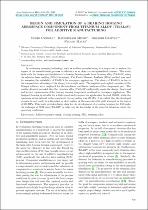 ResearchSpace
ResearchSpace
Design and simulation of a bearing housing aerospace component from titanium alloy (TI6AL4V) for additive manufacturing
JavaScript is disabled for your browser. Some features of this site may not work without it.
- ResearchSpace
- →
- Research Publications/Outputs
- →
- Journal Articles
- →
- View Item
| dc.contributor.author |
Oyesola, M

|
|
| dc.contributor.author |
Mpofu, K

|
|
| dc.contributor.author |
Daniyan, I

|
|
| dc.contributor.author |
Mathe, Ntombizodwa R

|
|
| dc.date.accessioned | 2023-05-12T14:02:46Z | |
| dc.date.available | 2023-05-12T14:02:46Z | |
| dc.date.issued | 2022-12 | |
| dc.identifier.citation | Oyesola, M., Mpofu, K., Daniyan, I. & Mathe, N.R. 2022. Design and simulation of a bearing housing aerospace component from titanium alloy (TI6AL4V) for additive manufacturing. <i>Acta Polytechnica, 62(6).</i> http://hdl.handle.net/10204/12784 | en_ZA |
| dc.identifier.issn | 1210-2709 | |
| dc.identifier.issn | 1805-2363 | |
| dc.identifier.uri | https://doi.org/10.14311/AP.2022.62.0639 | |
| dc.identifier.uri | http://hdl.handle.net/10204/12784 | |
| dc.description.abstract | In evaluating emerging technology, such as additive manufacturing, it is important to analyse the impact of the manufacturing process on efficiency in an objective and quantifiable manner. This study deals with the design and simulation of a bearing housing made from titanium alloy (Ti6Al4V) using the selective laser melting (SLM) technique. The Finite Element Analysis (FEA) method was used for assessing the suitability of Ti6Al4V for aerospace application. The choice of Ti6Al4V is due to the comparative advantage of its strength-to-weight ratio. The implicit and explicit modules of the Abaqus software were employed for the non-linear and linear analyses of the component part. The results obtained revealed that the titanium alloy (Ti6Al4V) sufficiently meets the design, functional and service requirements of the bearing housing component produced for aerospace application. The designed bearing is suitable for a high speed and temperature application beyond 1900 K, while the maximum stress induced in the component during loading was 521 kPa. It is evident that the developed stresses do not result in a distortion or deformation of the material with yield strength in the region of 820 MPa. This work provides design data for the development of a bearing housing for AM under the technique of SLM using Ti6Al4V by reflecting the knowledge of the material behaviour under the operating conditions. | en_US |
| dc.format | Fulltext | en_US |
| dc.language.iso | en | en_US |
| dc.relation.uri | https://ojs.cvut.cz/ojs/index.php/ap/article/view/8129 | en_US |
| dc.source | Acta Polytechnica, 62(6) | en_US |
| dc.subject | Additive manufacturing | en_US |
| dc.subject | Bearing housing | en_US |
| dc.subject | Emerging technologies | en_US |
| dc.subject | Finite Element Analysis | en_US |
| dc.subject | FEA | en_US |
| dc.subject | Selective laser melting | en_US |
| dc.subject | Titanium alloys | en_US |
| dc.title | Design and simulation of a bearing housing aerospace component from titanium alloy (TI6AL4V) for additive manufacturing | en_US |
| dc.type | Article | en_US |
| dc.description.pages | 15pp | en_US |
| dc.description.note | © 2022 The Author(s). Licensed under a CC-BY 4.0 licence. | en_US |
| dc.description.cluster | Manufacturing | en_US |
| dc.description.impactarea | Laser Enabled Manufacturing | en_US |
| dc.identifier.apacitation | Oyesola, M., Mpofu, K., Daniyan, I., & Mathe, N. R. (2022). Design and simulation of a bearing housing aerospace component from titanium alloy (TI6AL4V) for additive manufacturing. <i>Acta Polytechnica, 62(6)</i>, http://hdl.handle.net/10204/12784 | en_ZA |
| dc.identifier.chicagocitation | Oyesola, M, K Mpofu, I Daniyan, and Ntombizodwa R Mathe "Design and simulation of a bearing housing aerospace component from titanium alloy (TI6AL4V) for additive manufacturing." <i>Acta Polytechnica, 62(6)</i> (2022) http://hdl.handle.net/10204/12784 | en_ZA |
| dc.identifier.vancouvercitation | Oyesola M, Mpofu K, Daniyan I, Mathe NR. Design and simulation of a bearing housing aerospace component from titanium alloy (TI6AL4V) for additive manufacturing. Acta Polytechnica, 62(6). 2022; http://hdl.handle.net/10204/12784. | en_ZA |
| dc.identifier.ris | TY - Article AU - Oyesola, M AU - Mpofu, K AU - Daniyan, I AU - Mathe, Ntombizodwa R AB - In evaluating emerging technology, such as additive manufacturing, it is important to analyse the impact of the manufacturing process on efficiency in an objective and quantifiable manner. This study deals with the design and simulation of a bearing housing made from titanium alloy (Ti6Al4V) using the selective laser melting (SLM) technique. The Finite Element Analysis (FEA) method was used for assessing the suitability of Ti6Al4V for aerospace application. The choice of Ti6Al4V is due to the comparative advantage of its strength-to-weight ratio. The implicit and explicit modules of the Abaqus software were employed for the non-linear and linear analyses of the component part. The results obtained revealed that the titanium alloy (Ti6Al4V) sufficiently meets the design, functional and service requirements of the bearing housing component produced for aerospace application. The designed bearing is suitable for a high speed and temperature application beyond 1900 K, while the maximum stress induced in the component during loading was 521 kPa. It is evident that the developed stresses do not result in a distortion or deformation of the material with yield strength in the region of 820 MPa. This work provides design data for the development of a bearing housing for AM under the technique of SLM using Ti6Al4V by reflecting the knowledge of the material behaviour under the operating conditions. DA - 2022-12 DB - ResearchSpace DP - CSIR J1 - Acta Polytechnica, 62(6) KW - Additive manufacturing KW - Bearing housing KW - Emerging technologies KW - Finite Element Analysis KW - FEA KW - Selective laser melting KW - Titanium alloys LK - https://researchspace.csir.co.za PY - 2022 SM - 1210-2709 SM - 1805-2363 T1 - Design and simulation of a bearing housing aerospace component from titanium alloy (TI6AL4V) for additive manufacturing TI - Design and simulation of a bearing housing aerospace component from titanium alloy (TI6AL4V) for additive manufacturing UR - http://hdl.handle.net/10204/12784 ER - | en_ZA |
| dc.identifier.worklist | 26698 | en_US |





